Tectonic and Stratigraphic Evolution Based on Seismic Sequence Stratigraphy: Central Rift Section of the Campos Basin, Offshore Brazil
Abstract
:1. Introduction
2. Geological Setting
3. Sequence Stratigraphy and Adaptation for Rift Basins
4. Campos Basin Sequence Stratigraphy
4.1. Seismic Analysis Procedure
4.1.1. Reflector Terminations Analysis
4.1.2. Seismic Stratigraphic Units
4.1.3. Seismic Facies
4.1.4. Chronostratigraphic Chart
5. Discussion
5.1. Interpretation of the Controlling Variables and Seismic Stratigraphic Framework
5.1.1. Rift Initiation Systems Tract (RIST)
5.1.2. High Tectonic Activity Systems Tract (HTAST)
5.1.3. Low Tectonic Activity Systems Tract (LTAST)
6. Conclusions
Author Contributions
Funding
Informed Consent Statement
Data Availability Statement
Acknowledgments
Conflicts of Interest
References
- ANP. Painel Dinâmico de Produção de Petróleo e Gás Natural. 2021. Available online: https://www.gov.br/anp/pt-br/assuntos/exploracao-e-producao-de-oleo-e-gas/paineis-dinamicos-de-producao-de-petroleo-e-gas-natural (accessed on 31 March 2021).
- Tessari, E.; Tsubone, K.; Brisola, N. Acumulações petrolíferas da Bacia de Campos. In Proceedings of the Offshore Brazil Conference, Rio de Janeiro, Brazil, 24–26 October 1978; Volume 5, pp. 1–14. [Google Scholar]
- Guardado, L.R.; Spadini, A.R.; Brandão, J.S.L.; Mello, M.R. Petroleum system of the Campos Basin, Brazil. In Petroleum Systems of South Atlantic Margins; Katz, B.J., Mello, M.R., Eds.; AAPG Memoir: Tulsa, OK, USA, 2000; pp. 317–324. [Google Scholar]
- Formigli, J. Pre-salt reservoirs offshore Brazil. In Proceedings of the Perspectives and Challenges Energy Conference, Miami, FL, USA, 6–10 November 2007. [Google Scholar]
- Prosser, S. Rift-related linked depositional systems and their seismic expression. In Tectonics and Seismic Sequence Stratigraphy; Williams, G.D., Dobb, A., Eds.; Geological Society Special Publication: London, UK, 1993; pp. 35–66. [Google Scholar]
- Kuchle, J.; Scherer, C.M.S. Sismoestratigrafia de bacias rifte: Técnicas, métodos e sua aplicação na Bacia do Recôncavo. Bol. Geociências Petrobras 2010, 18, 179–206. [Google Scholar]
- Rangel, H.D.; Martins, F.A.L.; Esteves, F.R.; Feijó, F.J. Bacia de Campos. Bol. Geociências Petrobras 1994, 8, 203–218. [Google Scholar]
- Rangel, H.D.; Carminatti, M. Rift lake stratigraphy of the Lagoa Feia Formation, Campos Basin, Brazil. In Lake Basins through Space and Time; Gierlowski-Kordesch, E.H., Kelts, K.R., Eds.; AAPG Studies in Geology: Tulsa, OK, USA, 2000; pp. 225–244. [Google Scholar]
- Dias, J.L.; Scarton, J.C.; Esteves, F.R.; Carminatti, M.; Guardado, L.R. Aspectos da evolução tectono-sedimentar e a ocorrência de hidrocarbonetos na Bacia de Campos. In Origem e Evolução de Bacias Sedimentares; Raja Gabaglia, G.P., Milani, E.J., Eds.; Petrobras, CENSUD: Rio de Janeiro, Brazil, 1990; pp. 333–360. [Google Scholar]
- Goldberg, K.; Kuchle, J.; Scherer, C.; Alvarenga, R.S.; Ene, P.L.; Armelenti, G.; de Ros, L.F. Re-sedimented deposits in the rift section of the Campos Basin. Mar. Pet. Geol. 2017, 80, 412–431. [Google Scholar] [CrossRef]
- Chang, H.K.; Kowsmann, R.O.; Bender, A.A.; Mello, U.T. Origem e evolução termomecânica de bacias sedimentares. In Origem e Evolução de Bacias Sedimentares; Raja Gabaglia, G.P., Milani, E.J., Eds.; Petrobras, CENSUD: Rio de Janeiro, Brazil, 1990; pp. 49–71. [Google Scholar]
- Moraes, M.A.S. Diagenetic evolution of Cretaceous-Tertiary turbidite reservoirs, Campos Basin, Brazil. AAPG Bull. 1989, 73, 598–612. [Google Scholar]
- Schaller, H. Estratigrafia de bacia de Campos. In Proceedings of the 27th Brazilian Congress of Geology, Aracaju, SE, Brazil, October 1973; pp. 247–258. [Google Scholar]
- Winter, W.R.; Jahnert, R.J.; França, A.B. Bacia de Campos. Bol. Geociências Petrobras 2007, 15, 511–529. [Google Scholar]
- Mizusaki, A.M.P.; Thomaz Filho, A.; Valença, J.G. Volcano-Sedimentary Sequence of Neocomian age in Campos Basin (Brazil). Rev. Bras. Geociências 1988, 18, 247–251. [Google Scholar] [CrossRef]
- Grassi, A.D.A.; Castro, A.H.A.; Albertão, G.A. Bacias Sedimentares Brasileiras—Bacia de Campos. Inf. Fundação Paleontológica Phoenix 2004, 65, 1–6. [Google Scholar]
- Catuneanu, O. Principles of Sequence Stratigraphy; Elsevier: Amsterdam, The Netherlands, 2006; p. 375. [Google Scholar]
- Alvarenga, R.S.; Iacopini, D.; Kuchle, J.; Scherer, C.M.S.; Goldberg, K. Seismic characteristics and distribution of hydrothermal vent complexes in the cretaceous offshore rift section of the Campos Basin, Offshore Brazil. Mar. Pet. Geol. 2016, 74, 12–25. [Google Scholar] [CrossRef]
- Vail, P.R.; Mitchum, R.M., Jr.; Todd, R.G.; Widmier, J.M.; Thompson, S.; Sangree, J.B.; Bubb, J.N.; Hatlelid, W.G. Seismic stratigraphy and global changes of sea level. In Seismic Stratigraphy—Applications to Hydrocarbon Exploration; Payton, C.E., Ed.; AAPG Memoir: Tulsa, OK, USA, 1977; pp. 49–212. [Google Scholar]
- Mitchum, R.M., Jr.; Vail, P.R.; Sangree, J.B. Seismic stratigraphy and global changes of sea level, part 6: Stratigraphic interpretation of seismic reflection patterns in depositional sequences. In Seismic Stratigraphy—Applications to Hydrocarbon Exploration; Payton, C.E., Ed.; AAPG Memoir: Tulsa, OK, USA, 1977; pp. 117–133. [Google Scholar]
- Posamentier, H.W.; Jervey, M.T.; Vail, P.R. Eustatic controls on clastic deposition I—Conceptual framework. In Sea-Level Changes: An Integrated Approach; Wilgus, C.K., Hastings, B.S., Posamentier, H., van Wagoner, J., Ross, C.A., Kendall, C.G.S.C., Eds.; SEPM Special Publication: Tulsa, OK, USA, 1988; pp. 109–124. [Google Scholar]
- Van Wagoner, J.C.; Mitchum, R.M.; Champion, K.M.; Rahmanian, V.D. Siliciclastic Sequence Stratigraphy in Well Logs, Cores, and Outcrops: Concepts for High Resolution Correlation of Time and Facies; Methods in Exploration Series, N° 7; American Association of Petroleum Geologists: Tulsa, OK, USA, 1990. [Google Scholar]
- Catuneanu, O.; Abreu, V.; Bhattacharya, J.P.; Blum, M.D.; Dalrymple, R.W.; Eriksson, P.G.; Fielding, C.R.; Fisher, W.L.; Galloway, W.E.; Gibling, M.R.; et al. Towards the standardization of sequence stratigraphy. Earth Sci. Rev. 2009, 92, 1–33. [Google Scholar] [CrossRef] [Green Version]
- Catuneanu, O. Model-independent sequence stratigraphy. Earth Sci. Rev. 2019, 188, 312–388. [Google Scholar] [CrossRef]
- Brown, L.F., Jr.; Fischer, W.L. Seismic interpretation of depositional systems: Examples from Brazilian rift and pull-apart basins. In Seismic Stratigraphy—Applications to Hydrocarbon Exploration; Payton, C.E., Ed.; AAPG Memoir: Tulsa, OK, USA, 1977; pp. 213–248. [Google Scholar]
- Bosence, D.W.J. Stratigraphic and sedimentological models of rift basins. In Sedimentation and Tectonics of Rift Basins: Red Sea—Gulf of Aden; Purser, B.H., Bosence, D., Eds.; Chapman & Hall: London, UK, 1998; pp. 9–25. [Google Scholar]
- Gawthorpe, R.L.; Leeder, M.R. Tectono-sedimentary evolution of active extensional basins. Basin Res. 2000, 12, 195–218. [Google Scholar] [CrossRef]
- Morley, C.K. Evolution of large normal faults: Evidence from sesmic reflection data. AAPG Bull. 2002, 86, 961–978. [Google Scholar]
- Martins-Neto, M.A.; Catuneanu, O. Rift sequence stratigraphy. Mar. Pet. Geol. 2010, 27, 247–253. [Google Scholar] [CrossRef]
- Hubbard, R.J.; Pape, J.; Roberts, D.G. Depositional sequence mapping as technique to establish tectonic and stratigraphic framework and evaluate hydrocarbon potential on a passive continental margin. In Seismic Stratigraphy II: An Integrated Approach to Hydrocarbon Exploration; Berg, O.R., Woolverton, D.G., Eds.; AAPG Memoir: Tulsa, OK, USA, 1985; Volume 39, pp. 79–91. [Google Scholar]
- Salvador, A. International Stratigraphic Guide: A Guide to Stratigraphic Classification, Terminology and Procedure; The International Union of Geological Science and the Geological Society of America: Boulder, CO, USA, 1994. [Google Scholar]
- Rosendahl, B.R.; Reynolds, D.J.; Lorber, P.M.; Burgess, C.F.; Mcgill, J.; Scott, D.; Lambiase, J.J.; Derksen, S.J. Structural expressions of rifting: Lessons from Lake Tanganyika, Africa. In Sedimentation in the African Rifts; Special Publication; Frostick, L.E., Ed.; Geological Society: London, UK, 1986; pp. 29–43. [Google Scholar]
- Vail, P.R.; Mitchum, R.M., Jr. Overview. In Seismic Stratigraphy—Applications to Hydrocarbon Exploration; Payton, C.E., Ed.; AAPG Memoir: Tulsa, OK, USA, 1977; pp. 51–52. [Google Scholar]
- Abreu, V. Evolution of the Conjugate Volcanic Passive Margins: Pelotas Basin (Brazil) and Offshore Namibia (Africa): Implication for Global Sea-Level Changes. Ph.D. Thesis, Rice University, Houston, TX, USA, 1998. [Google Scholar]
- Neal, J.; Abreu, V. Sequence stratigraphy hierarchy and the accommodation succession method. Geology 2009, 37, 779–782. [Google Scholar] [CrossRef]
- Wheeler, H.E. Time Stratigraphy. AAPG Bull. 1958, 42, 1047–1063. [Google Scholar]
- Armelenti, G.; Goldberg, K.; Kuchle, J.; de Ros, L.F. Deposition, diagenesis and reservoir potential of non-carbonate sedimentary rocks from the rift section of Campos Basin, Brazil. Pet. Geosci. 2016, 22, 223–239. [Google Scholar] [CrossRef]
- Playton, T.E.; Jason, X.; Kerans, C. Carbonate slopes. In Facies Models; James, N.P., Dalrymple, R.W., Eds.; Geological Association of Canada: St. John’s, NL, Canada, 2010; pp. 449–476. [Google Scholar]
- Abrahão, D.; Warme, J.E. Lacustrine and associated deposits in a rifted continental margin—Lower cretaceous lagoa feia formation, Campos Basin, offshore Brazil. In Lacustrine Basin Exploration: Case Studies and Modern Analogs; Katz, B.J., Ed.; AAPG Memoir: Tulsa, OK, USA, 1990; pp. 287–305. [Google Scholar]
- Olivito, J.P.R.; Souza, F.J. Depositional model of early Cretaceous lacustrine carbonate reservoirs of the Coqueiros formation—Northern Campos Basin, southeastern Brazil. Mar. Pet. Geol. 2020, 111, 414–439. [Google Scholar] [CrossRef]
- Thompson, D.L.; Stilwell, J.D.; Hall, M. Lacustrine carbonate reservoirs from Early Cretaceous rift lakes of Western Gondwana: Pre-Salt coquinas of Brazil and West Africa. Gondwana Res. 2015, 28, 26–51. [Google Scholar] [CrossRef]
- Muniz, M.; Bosence, D. Lacustrine carbonate platforms: Facies, cycles and tectonosedimentary models for the presalt Lagoa Feia Group (Lower Cretaceous), Campos Basin, Brazil. AAPG Bull. 2018, 102, 2569–2597. [Google Scholar] [CrossRef]
- Harris, N.B. Toca carbonate, Congo Basin: Response to an evolving rift lake. In Petroleum Systems of South Atlantic Margins; Melo, M.R., Katz, B.J., Eds.; AAPG Memoir: Tulsa, OK, USA, 2000; pp. 341–360. [Google Scholar]
- Barnett, A.J.; Fu, L.; Rapasi, T.; Scotellaro, C.; Guha, J.; Cabolova, A.; Domingues, A.L. Seismic characterisation and origin of clinoforms in lacustrine depositional environments: A case study from the Cretaceous of the South Atlantic. Geol. Soc. Lond. Spec. Publ. 2020, 509, 127–145. [Google Scholar] [CrossRef]
- Alvarenga, R.S.; Kuchle, J.; Iacopini, D.; Ene, P.; Scherer, C.M.S.; Goldberg, K. Reconhecimento e análise das fácies sísmicas nas sucessões rift das bacias de Campos e Santos. Pesqui. Geociências 2018, 43, 325–334. [Google Scholar] [CrossRef] [Green Version]

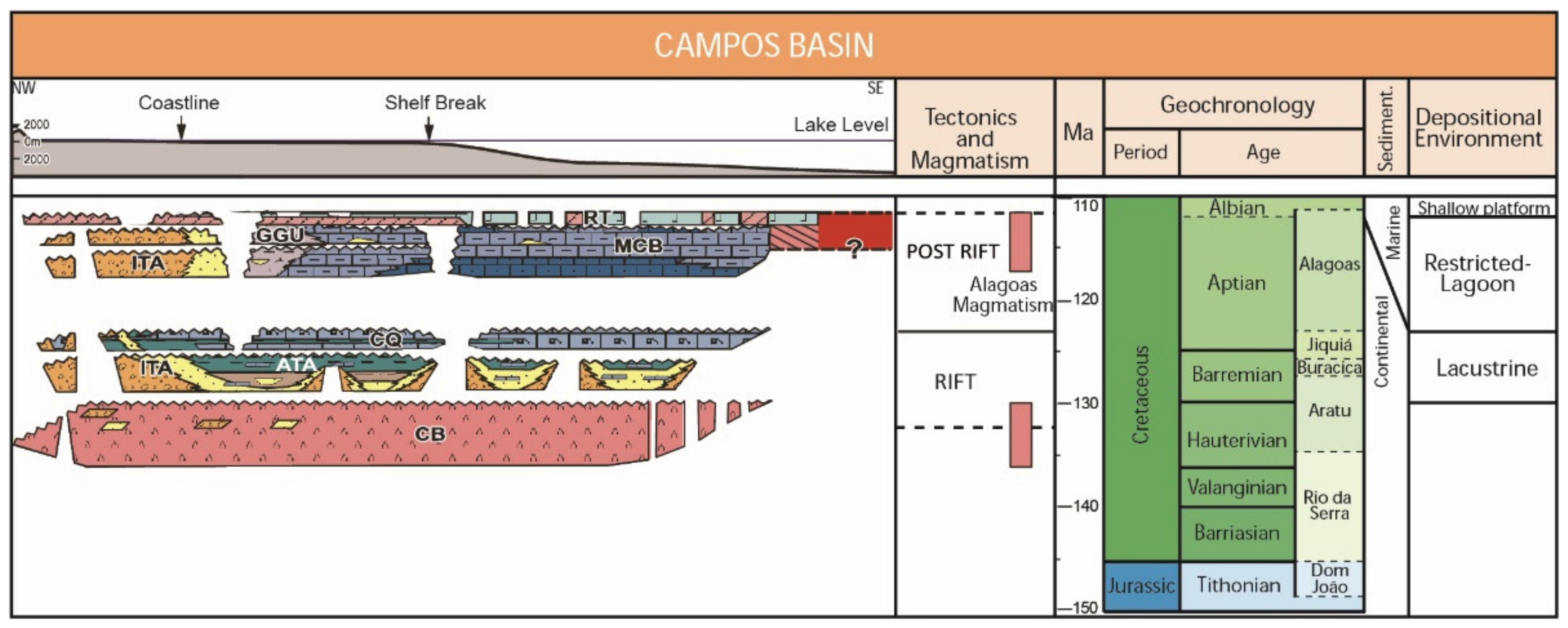
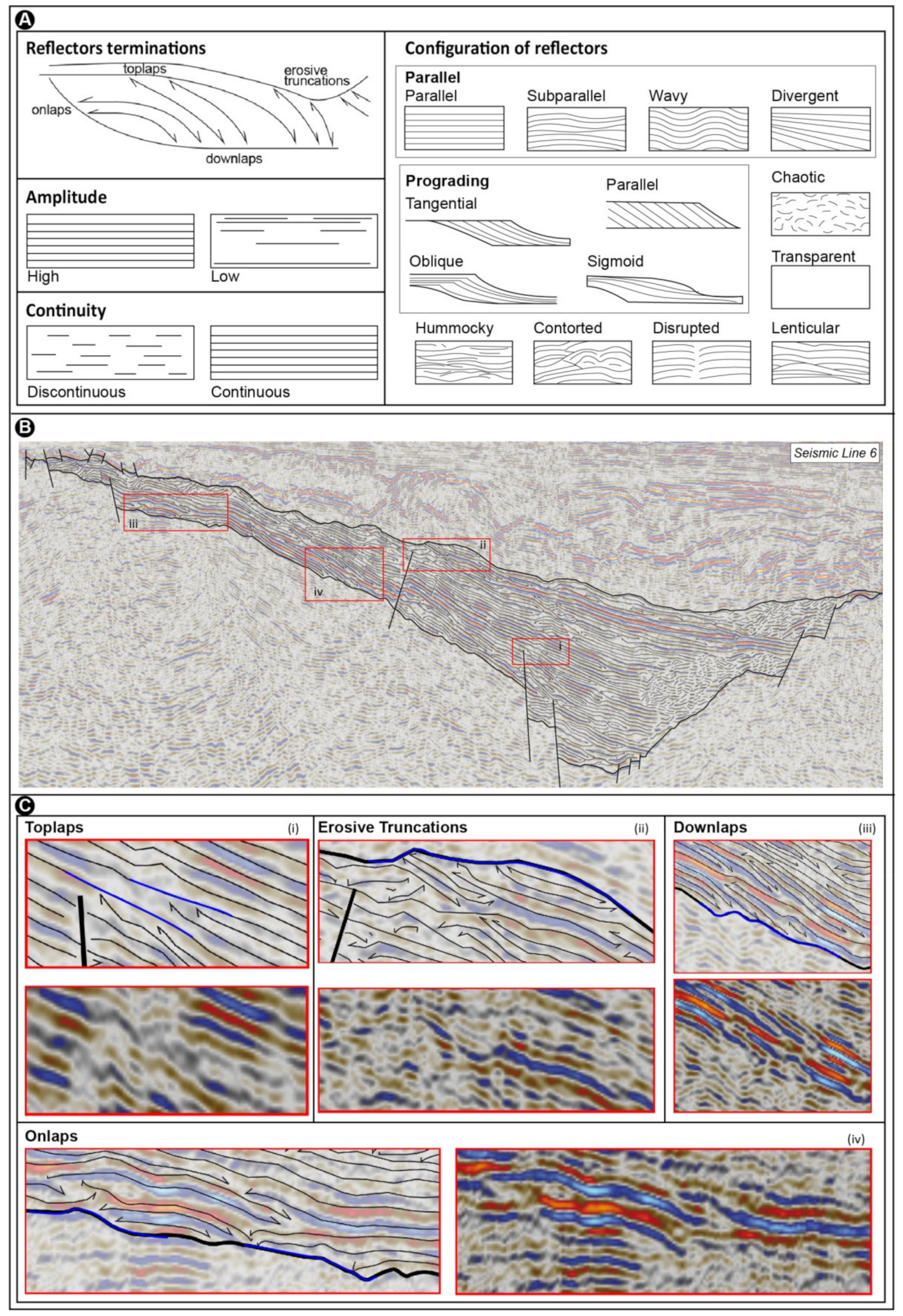
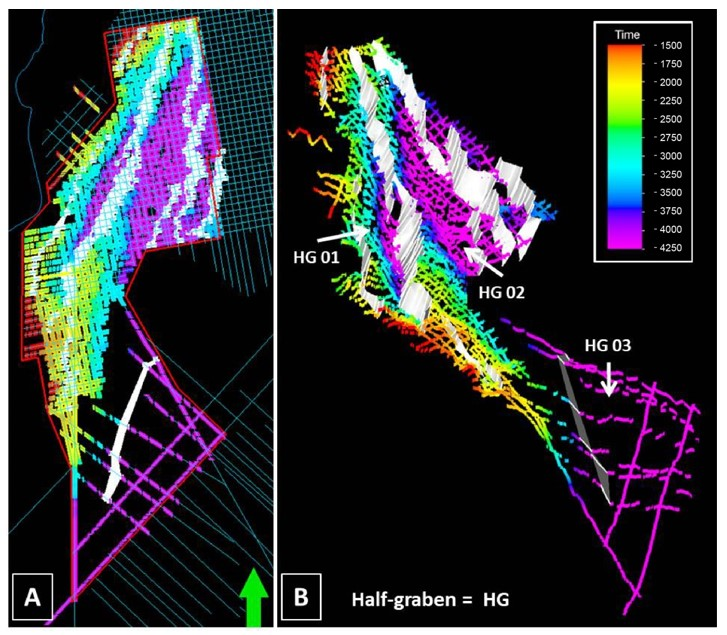
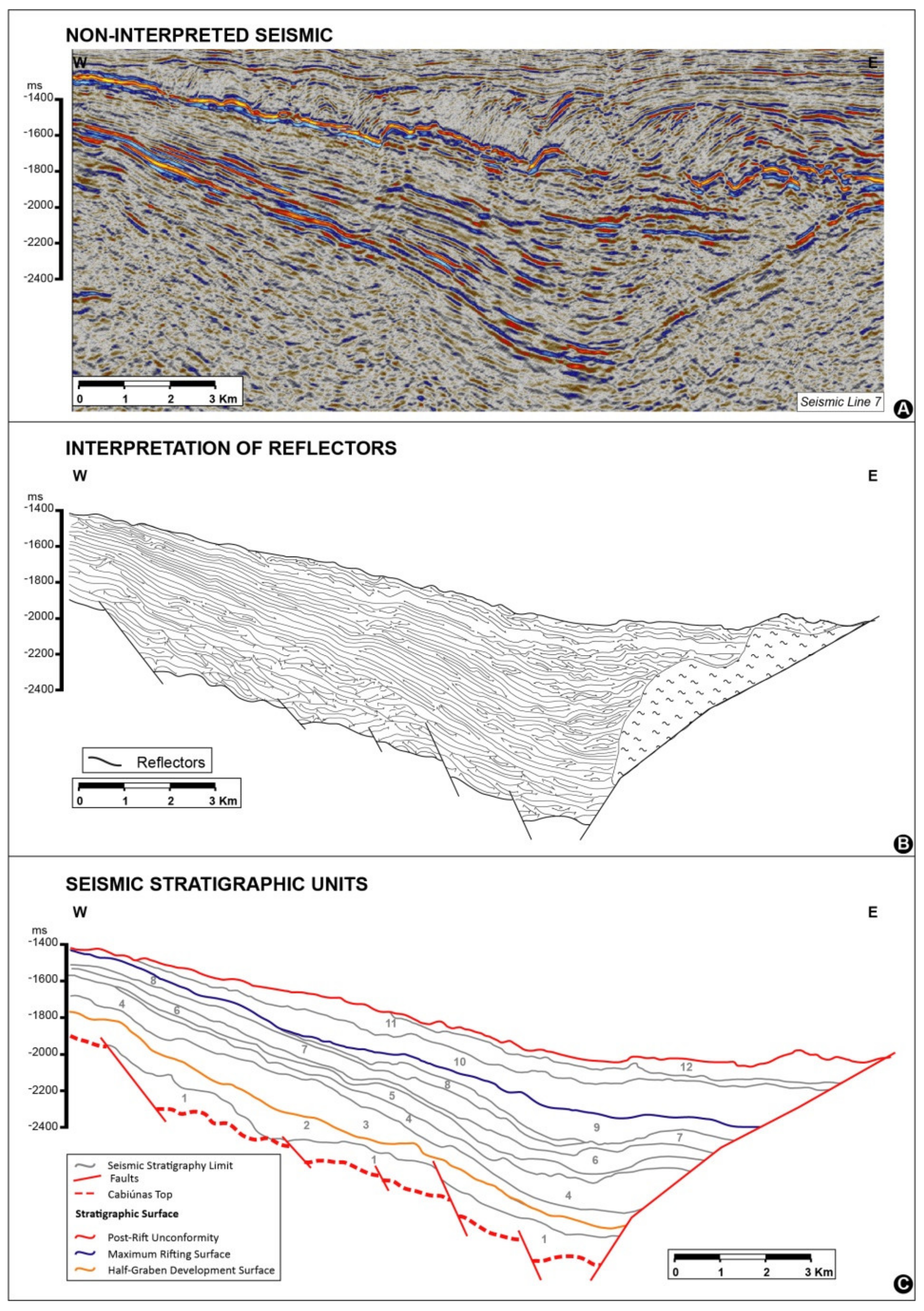
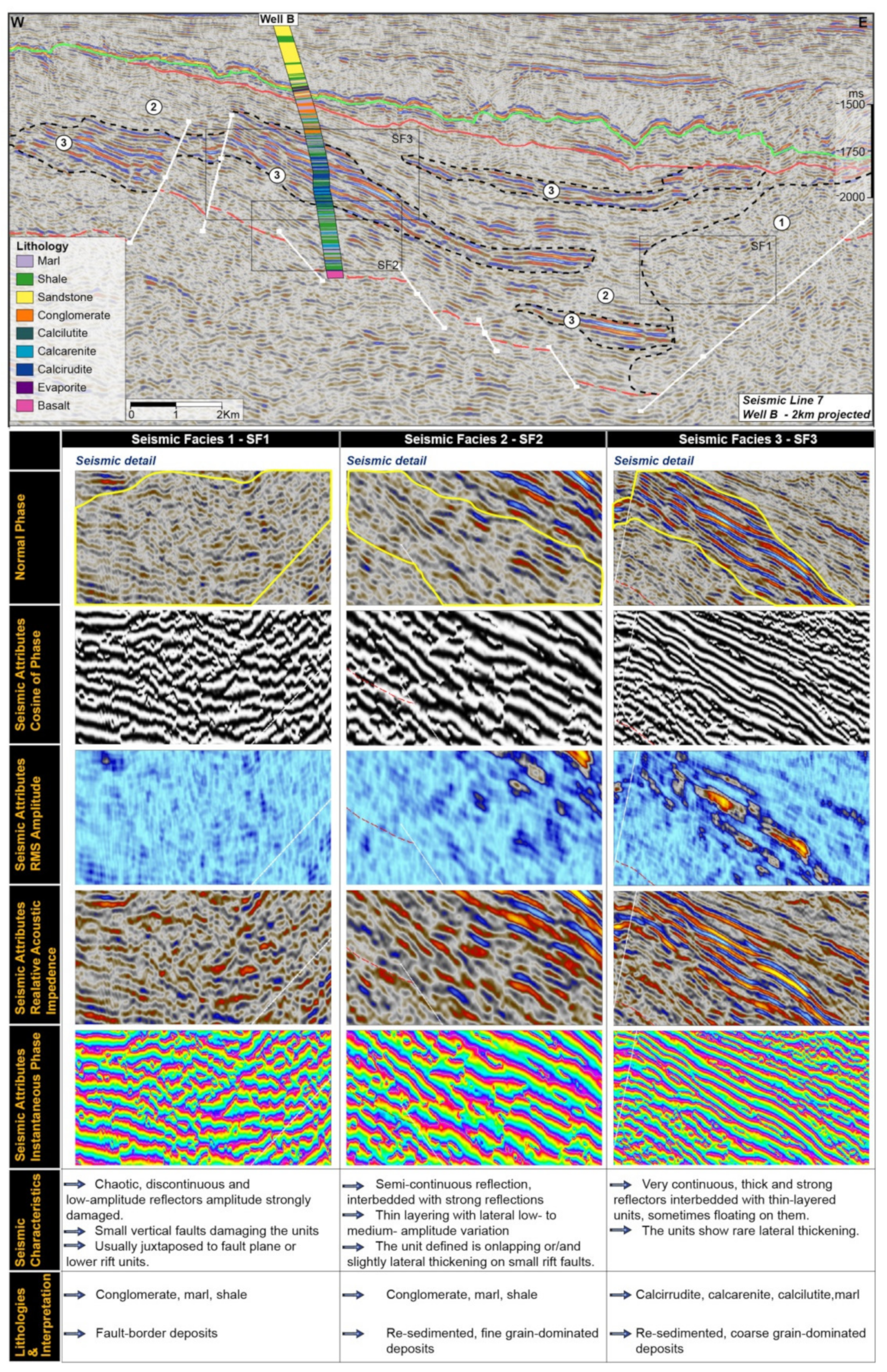
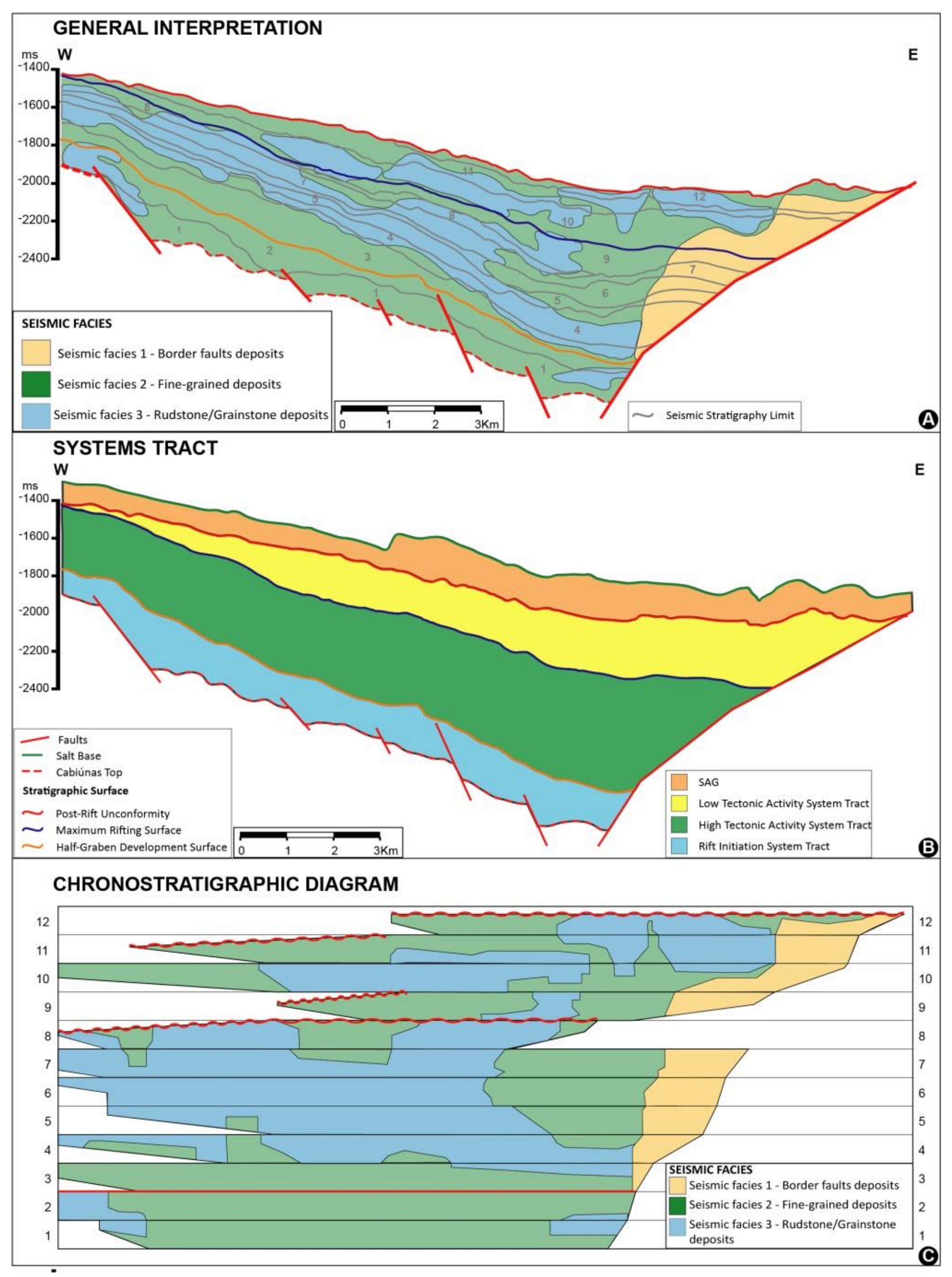
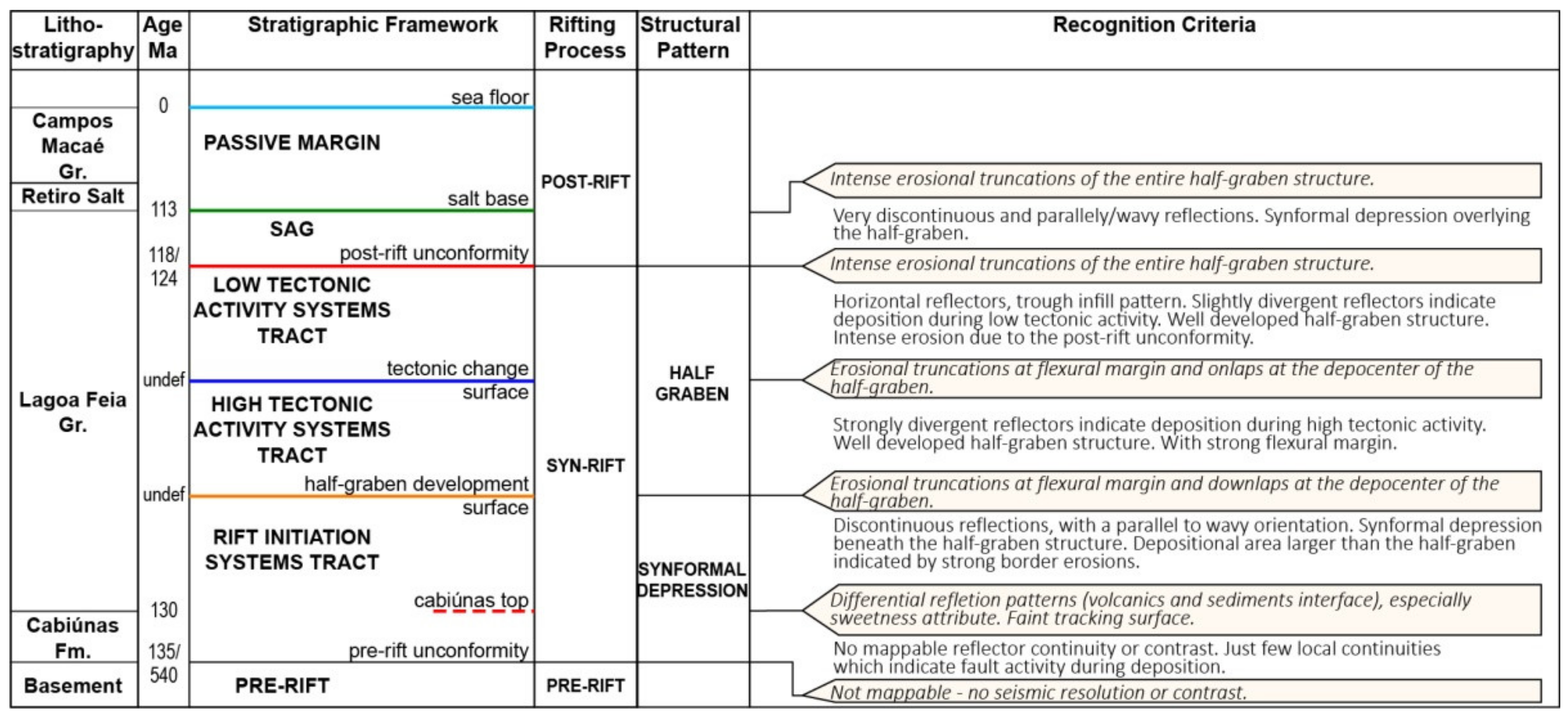

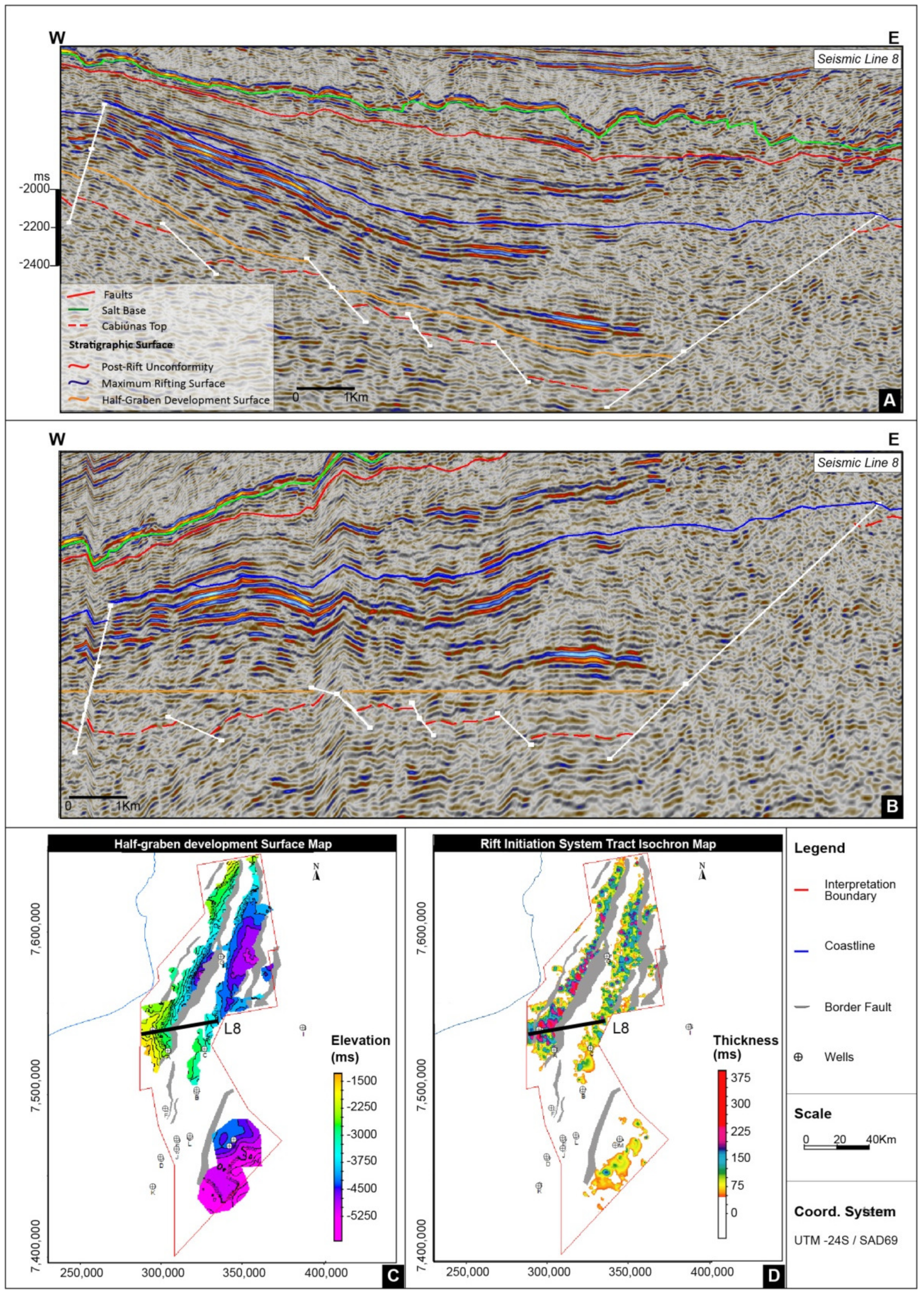
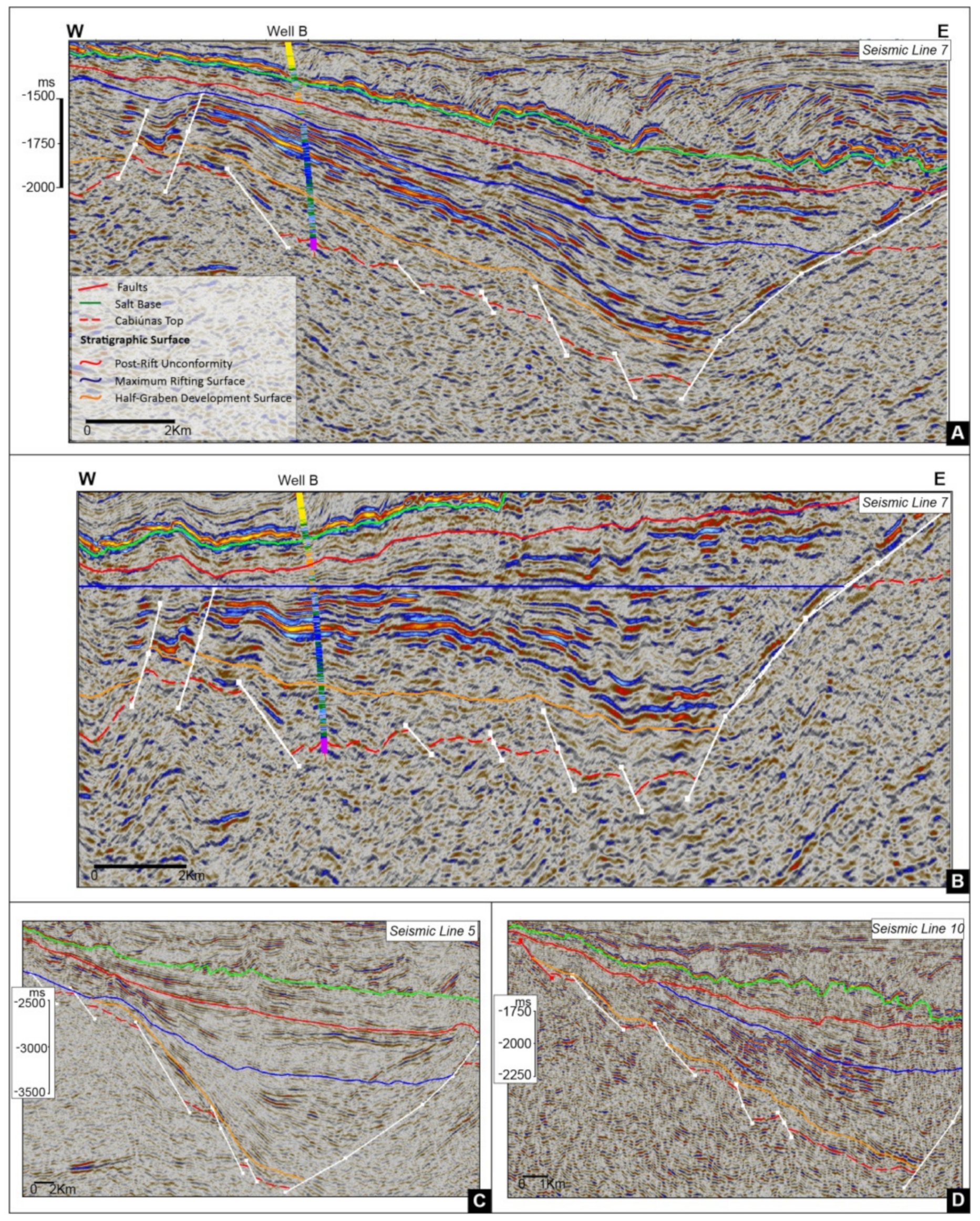

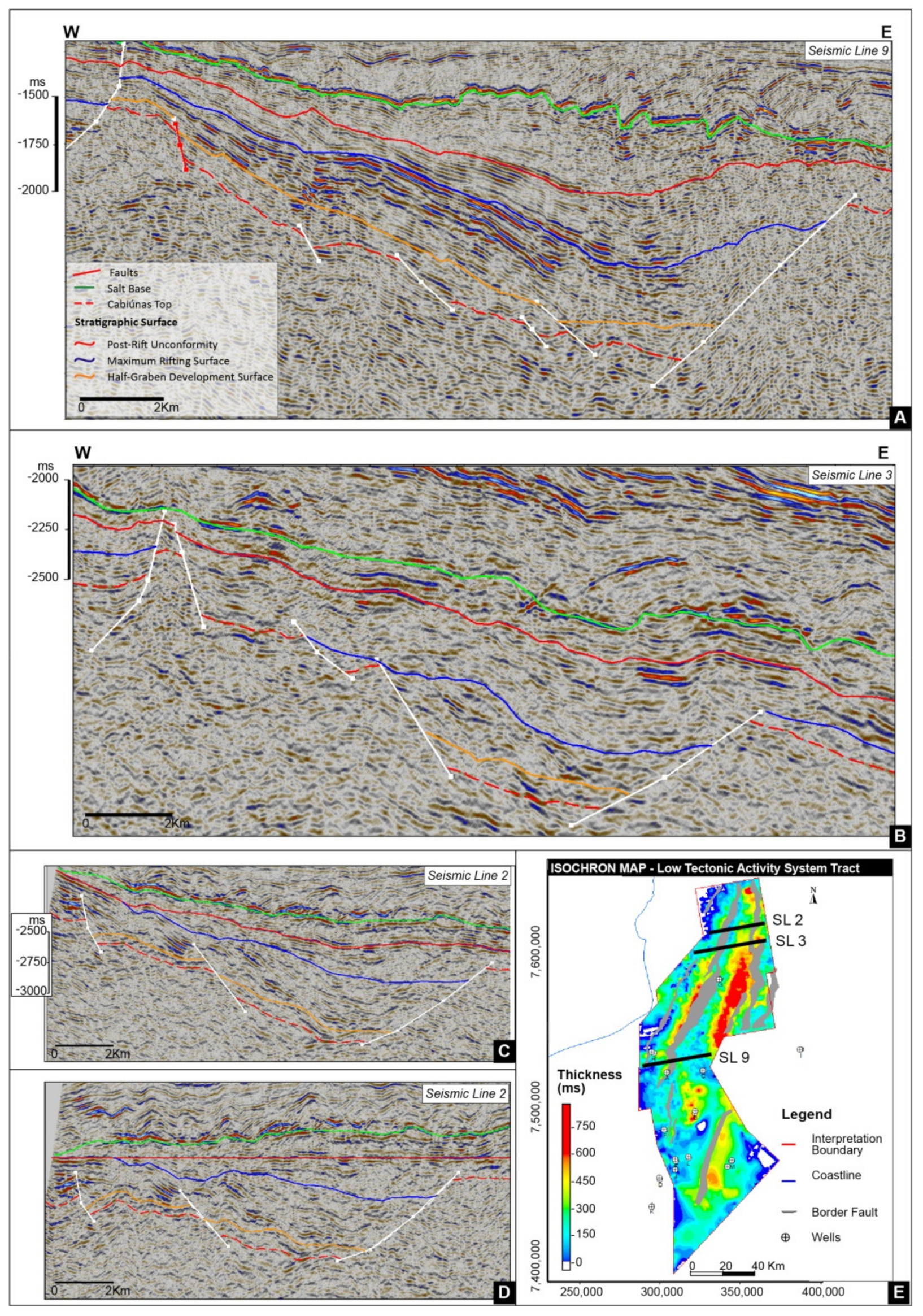
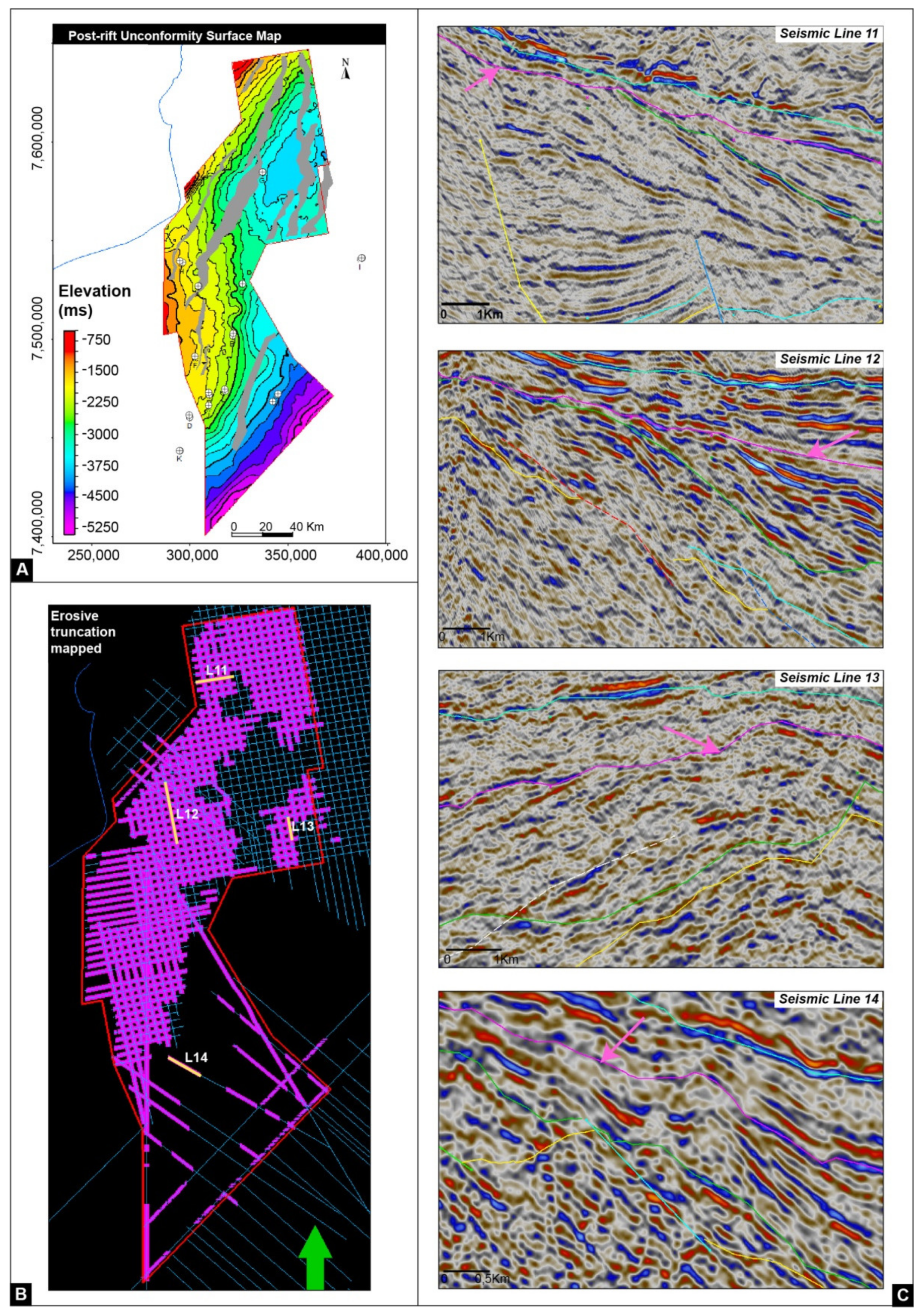
Publisher’s Note: MDPI stays neutral with regard to jurisdictional claims in published maps and institutional affiliations. |
© 2021 by the authors. Licensee MDPI, Basel, Switzerland. This article is an open access article distributed under the terms and conditions of the Creative Commons Attribution (CC BY) license (https://creativecommons.org/licenses/by/4.0/).
Share and Cite
Alvarenga, R.d.S.; Kuchle, J.; Iacopini, D.; Goldberg, K.; Scherer, C.M.d.S.; Pantopoulos, G.; Ene, P.L. Tectonic and Stratigraphic Evolution Based on Seismic Sequence Stratigraphy: Central Rift Section of the Campos Basin, Offshore Brazil. Geosciences 2021, 11, 338. https://doi.org/10.3390/geosciences11080338
Alvarenga RdS, Kuchle J, Iacopini D, Goldberg K, Scherer CMdS, Pantopoulos G, Ene PL. Tectonic and Stratigraphic Evolution Based on Seismic Sequence Stratigraphy: Central Rift Section of the Campos Basin, Offshore Brazil. Geosciences. 2021; 11(8):338. https://doi.org/10.3390/geosciences11080338
Chicago/Turabian StyleAlvarenga, Renata dos Santos, Juliano Kuchle, David Iacopini, Karin Goldberg, Claiton Marlon dos Santos Scherer, George Pantopoulos, and Patrycia Leipnitz Ene. 2021. "Tectonic and Stratigraphic Evolution Based on Seismic Sequence Stratigraphy: Central Rift Section of the Campos Basin, Offshore Brazil" Geosciences 11, no. 8: 338. https://doi.org/10.3390/geosciences11080338





